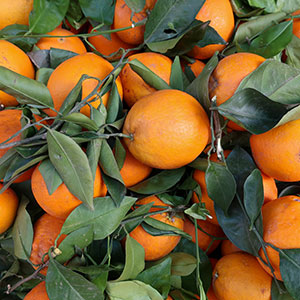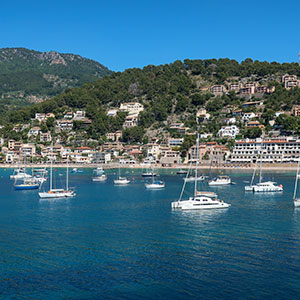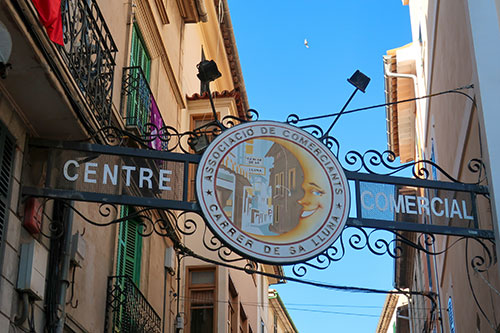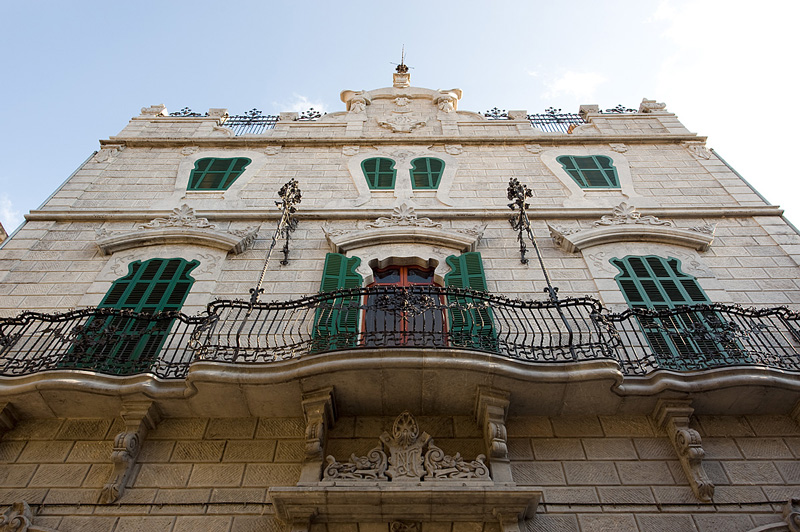Sóller is a town nestled on the northern coast of the well known Balearic Island of Majorca. It has a rich history which’s traces can still be seen in the town today. Sóllers position on the north side of the Island of Majorca is Isolated as its cut off from the other towns and villages on the island by the vast Serra de Tramuntana mountain range, with its highest peak Puig Major at over 1440 meters being the tallest mountain on any of the Balearic Islands. This isolation and unique position within the Balearic Islands made the town an ideal trading port with French Sailors and Merchants who arrived on ships. Historically this trade gave life to the town, in more recent times this has been replaced by tourism and complemented by a focus on farming olive and citrus trees.
The citrus trade in Soller

The success of Sóller as a town can be attributed to the success of its citrus fruit trade with French Merchants. There are records of the traces of French settles on the island on the Island of Majorca in the 5th Century followed by the island being conquered by Jaume I, the Lord of Montpellier in 1229. There are two other historic occupations that need to be mentioned which set the foundation for the history of agriculture on the island and for the town Sóller which happened before the French arrived. The island was conquered by the romans in 123 and the romans introduced the first olive trees to the island. This was followed by the Moors occupations in 903 who set the foundation for irrigation systems to water plants on the island. Rather than for agriculture but more as an aesthetic they choose to plant orange tress for their aroma while the bark was used as a medicinal treatment. The name Sóller was given to this golden valley of citrus trees by Moorish Lords, the name Sóller derived from the word “Suljer” meaning golden valley.
The start of the closely knit relationship between Sóller and France is marked trough one of the most significant events in French History, the rebellion of 1789. Many native French inhabitants decided to move to the town of Sóller and there planted orange groves. These inhabitants came from the South of France and thus established a trade relationship with Port Towns in the south of the country.

These towns include Marseille, Montpellier and Cannes. This was the start of a very fruitful relationship for the Port town of Sóller. This trade was cut short through a plague of Insects decimating the plantations in the 60s and resulted in many inhabitants of Sóller who had earned their living through agriculture to leave the Island and town for mainland France. A lot of Sollerics who had chosen to emigrate eventually did return to the town and introduced a more central European flair to the town. They had been enthralled by the impressive baroque or neo classic French architecture seen in many of the French towns and wanted to introduce it to the coastal northerly town of Sóller. The French Baroque style is characterised by a geometry and has less elaborate decoration on the facade of the building and indoor spaces in comparison to some of the other central European baroque styles. Those who returned from France not only introduced architectural styles but also ways of thinking. The returnees introduced Spain to an international style of art and applied art which in Spain and Sóller took form as Modernism. It introduced a way of thinking in which beauty can be found not only in art and architecture but also in language and literary works. Those who had returned from France not only with wealth but also with a more rounded cultural identity where now considered the new social elite.
French architecture in Soller

This architectural revival and cultural boom in the town can be best signified by the architect Joan Rubio y Belver who is well known for his contributions and work to the Modernist movement. He was a keen student of Gaudi and worked together with him on a range of projects. Two examples of his notable work in Sóller include his design of the facade of the church of Santa Bartomeub. The church is unusual in that it is mostly baroque in nature having been built between 1688 and 1723, having a gothic interior but Rubio adorned it with this modernist facade in 1904. 8 years later Rubio began work on the Bank of Sóller. The influence of working under Gaudi is clear to see in the church as it shares his characteristic architectural style, a balcony, a fluted column and windows of different sizes. Some other buildings of note in the town include a neoclassical Palace La Posada de Montclair which was built in the 18th Century. Many of the most successful returnees settled on the Gran Via avenue in the town and built a selection of manor houses with Mares stone facades and wrought iron balconies funded by the proceeds of the citrus business.
At the start of the 20th Century the Citrus business underwent a rejuvenation and boom which further funded the expansion and realisation of this new lavish French style in the town. As the trading relationship between the southern French ports and Sóller strengthened the impact of French culture on day to day live on the port town only strengthened and grew. They began to return with French products such as furniture, ornate decorations, agricultural farming tools that they could not source on the island itself. Sóllers unique position meant that for the town it made more sense to satisfy its needs by importing required goods via Sea rather than the long over land route. The main connection between Sóller and the capital of Mallorca is the Ferrocarril de Sóller which for a long time was referred to as the orange express. The electric train was built in 1911 with money that had been amassed through the orange trade. The route takes the train from the islands capital on a long winding route through a series of tunnels in the Serra de Tramuntana mountain range before arriving in Sóller, the journey takes about an hour to cover the 27km trip.
Soller as a cultural hotspot

The Port of Sóller started as a small port which supplied the nearby town of Sóller with freshly caught fish. Due to the roaring citrus trade it greatly expanded to be one of the main trading hubs on the island. The port has now reinvented itself and caters for tourism with a range of hotels and eateries. It is beautifully set within a bay with two headlands flanking it on each side atop which two lighthouses sit. The town can only be described as a cultural hotspot and the impact of modernism can still be seen in the town through the range of museums and art galleries that can be visited. The museum is set in an art nouveau mansion built in the 20th Century. Can Prunera and his family amassed their wealth in France after leaving Sóller through fruit trading, and liqueur import and export and are one of the many Sollerics who returned to the island. With their newly amassed wealth they wanted to introduce the island to modernism and commission the Can Prunera which was built between 1904 and 1911. The museum houses works of some of the most famous artists of our time including Kadinsky, Picasso and Warhol. It also houses works of the local artist Francesca Martí. Other cultural attractions which explore just how big the impact the citrus trade and the relationship with France was is the Sóller Marine Museum. The marine museum is set on the site of an ancient monastery. The museum explores how Sóller is isolated and unique position the wrong side of a mountain range led to a fruitful trading relationship with the rest of Europe and just why this relationship was much stronger than any of the other towns and villages in Majorca had. The French still have an affinity for the town and for the island being the third most popular residents on the island. There a range of French and Mediterranean restaurants dotted around the town. The impact that the trade relationship had with the town cannot be underestimated. Both through the emigration of French natives to the island and the return of Soleras the very architecture and fabric of the town has been shaped. You can see the impact in the buildings, the churches the museums but too in the way of thinking. The town has the flair of a European city, it has an awareness of itself, a cultural identity that in turn make it very desirable to anyone coming from Europe. It is amazing that those who returned to the island isolated on the far side of the mountain on the north of an island in the ocean managed to make it a modern cultural hotspot like any city that can be found on mainland Europe.
Looking for Soller Real Estate?
Are looking to buy a family home in Soller? Looking to relocate to Soller? Thinking about investing in a holiday home in Soller and the Soller Valley? Soller Properties team will guide you through the entire process. We do have the best property selection and the most exclusive network in the Soller, Biniaraix, Fornalutx, Port de Soller and Deia. Register with us and you will access off market properties that are not published on any website! Our multilingual team will make your soller property search easy and enjoyable. Access our off-market portfolio by registering here.